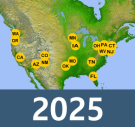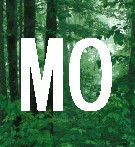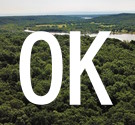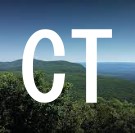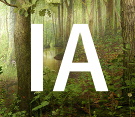|
|

|
Adopting the Navajo Model
by Matt Moneymaker 12/30/22
The BFRO has been collecting
sighting information since 1995. A little less than 6,000 of those
reports have been made public on the BFRO website, out of a bit more
than 75,000 reports received.
That full growing body of
information was very useful in finding witnesses and locations for the
Animal Planet Channel series "Finding Bigfoot." The same information
will be helpful to state government wildlife researchers and naturalists
who want to look into the matter of bigfoots spotted in their states.
If one of their own people has an encounter or finds tracks,
they may want to know if other encounters have been reported in the same
area, for example. Also, if people generally want bigfoots to be
protected, then it will be very helpful for state wildlife researchers
to know where they are spotted, and where they are not spotted (just as
important).
It is appropriate to normalize the access to
sighting information by state gov wildlife/forest caretakers for a
variety of reasons.
Many people in the BFRO would naturally want
me to be very careful about that. They would not want the information to
be used for destructive purposes. If our own people have concerns about
that, then many others will as well.
We will invite only one or two
people from each state. We will start with only a few states, and it
will only be state people in wildlife related positions (naturalist,
game warden, woodland fire department, etc.) who WE ALREADY KNOW.
I wanted to gauge whether there is a common feeling out there that
any government access puts bigfoots at risk somehow, so I put the
question to people on the BFRO's official Facebook Group ("BFRO 1995").
So far most of the respondents said they would actually be more
inclined to report a sighting if state wildlife people were receiving
the reports also, after I pointed out that protecting the species would
require state wildlife people to know about them, even if it's just
reports from the public.
In the past, it was common to hear a
deep distrust of the government from witnesses. But it was, and still
is, even more common that witnesses felt their info should be available
to legitimate wildlife researchers, which might naturally include some
government wildlife department people. So if witnesses don't trust "the
government" we don't interpret that to mean they wouldn't give their
information to state wildlife experts about what they saw.
There
is definitely a common feeling that "these creatures should be
protected."
Protecting these creatures won't simply be a matter of announcing severe legal
punishments for anyone who harms one. In many cases that sentiment will
translate to protecting certain areas. State gov people need to know or
figure out those areas, especially the ones that are strategically vital
for a given group of bigfoots in a given county or national forest.
That's how you really protect them. The biggest threats by humans are
not direct.
When the BFRO's internal database of sighting
information for a given county (on average 90% is not published) is
digested it often points to certain areas within a county. It also shows
that large portions in those counties have zero sighting reports.
Compare
that to deer, which will be spotted occasionally in most parts of most
counties in most US states. Bigfoots are very rare compared to deer.
State wildlife people need to see that too, for example.
Across
all the genuine habitat areas for bigfoots, only a fraction are
crucially vital for particular populations. Those habitats (usually
seasonal) need to be protected as development penetrates the surrounding
forest lands, especially in states where it is happening rapidly, like
in Texas, Florida and Washington etc.
BFRO people already know a
few state wildlife people in a few states who want to receive sighting
reports. Those people were not selected by the state to be the official
liaison to the BFRO, rather they met us over the years because they were
genuinely interested in the subject, and we were genuinely happy that
they were genuinely interested. There should be more official channels
like this, but it takes a long while to grow organically.
To that end we are now
recommending the "Navajo Model" to state and/or county governments.
There should be a go-to pair at the county level in some cases because
out west some counties are as large as some states back east.
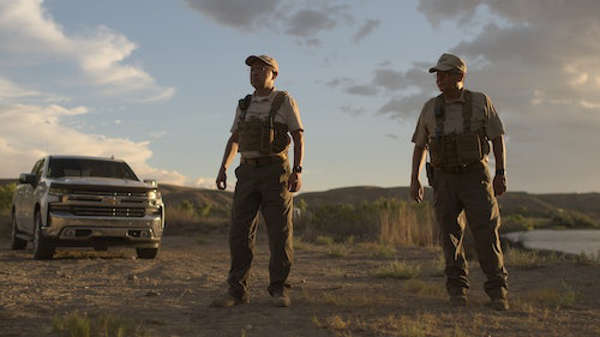
If you’ve watched the Netflix episode of Unsolved Mysteries (Season 3)
focusing on the Navajo Indian Reservation, you will recall how Navajo
authorities were forced to contend with strange sighting reports from the Navajo
Rez.
Like in basically all jurisdictions of North America, the regular
Navajo first responders (police, fire, etc.) didn’t want to deal with paranormal
type sightings and encounters (UFOs, ghosts, Bigfoots) for various practical and
political reasons, including the reason that heated debates would naturally
arise about what the priorities should be for local first responders. Big can ‘o
worms best kept sealed.
The governmental conundrum for the Navajos was
driven by the fact that many people in those communities were getting frightened
by a variety of paranormal activity which is very abundant in that part of the
country ... and you know that is no joke if you've ever spent time around there
at night. Think Skinwalker Ranch, right next door. It's not just the natives
describing the wild stuff down there.
These incidents frightened the
people who reported them to Navajo police. Navajo police (like everywhere else)
didn’t know what to do about the reports, so they didn’t do anything (like
everywhere else).
Some tribal members disliked (understatement) the feeling that they were not
being taken seriously by the police … about what scared them half to death. It
raised so many questions about their safety, and the safety of their family,
livestock and pets.
At least one of those witnesses made an official
complaint to the tribal council. That first complaint seemed a harbinger for
more complaints of the same type, so the Navajo police had to think it through
and come up with a functional solution, and they did. Their analysis and
solution is a real model for every other jurisdiction. It’s not a blueprint, but
rather a process of analysis to determine how to solve the problem.
The
Navajo Rez is spacious and sparsely populated. It is the size of West Virginia.
It is vast but there are only 175,000 people. West Virginia, by contrast, has
1.783 *million* people yet does not feel crowded at all. Navajo land feels even
more uncrowded. It is mostly uninhabited, yet it is the most populated
reservation by a wide margin.
On the Navajo Rez there are different law
enforcement entities. The entity determined to be most appropriate for
investigating paranormal encounters etc., was the one for protecting all natural
resources out in the boonies (rather than street patrol police).
Because of the
topography of the reservation, the solution needed to be a division of rangers,
in part because rangers can get anywhere they need to be. They have access to
all sorts of transportion modes. The Navajo Rangers also have their own SWAT
division, so this would just be a new division — one that didn’t need anything
fancy in the way of weapons (because there was nothing to fight) but rather the
tools of investigators and journalists. They only needed their regular gear plus
cameras, audio recorders, note pads, maps, etc. The focus was on the witness
stories, because one very important goal was to make those frightened adamant
witnesses feel they were being taken seriously by authorities.
The local
government would then be prepared to address questions about those incidents,
and how they were being handled by authorities, and whether there seems to be
any danger to the community, etc. But prepared in a way that would not prompt
some people in town to complain that they did not receive timely police services
on some occasion because the cops were too busy investigating UFOs.
The
Navajo law-enforcement community had to walk a fine line, and they did for
years, and they were likely the first ones to do it, and do it with an official
government directive that was not secretive.
The functional application of the “Navajo Model” in other jurisdictions may lead
in some other direction, for sake of practicality or feasibility. It might end
up leading to a local volunteer fire department, for example, if there are no
rangers operating in that county. Firefighters or even forestry workers may be
the natural choice to utilize in remote areas not served by rangers.
On
the Navajo Rez the witnesses (and all their extended family members … which
extend pretty far on a Rez ... and can potentially vote you off the tribal
council) felt they were being respected and taken seriously when this ranger
team showed up to take down their story. Nobody else had a problem with that --
a special pair of rangers devoting some attention to those peoples'
non-emergency concerns.
That's all it took ... in the most paranormally
active place on Earth, the size of West Virginia. It was very efficient and very respectful. Moreover, the
responders could clearly see and feel that they were providing an important
community service when they spoke with those frightened tribal members.
The Navajo authorities saw that it could be done with two people from among the
rangers who would be particularly good at documentation, witness interviews,
etc.
The Navajo government didn’t need to provide answers to anything
after that. They just needed to let those rangers speak openly about whatever
they gathered and surmised.
Not surprisingly… those two Navajo rangers
who were so good at doing interviews, were particularly good at being
interviewed themselves. Their story about what they learned turned out to be
such a good story that many of outside Navajo land wanted to hear it. Catch that
episode on Netflix if you can.
I think that the Navajo situation will
reverberate among rural first responders in many places. Many lessons to be
drawn from their story.
____________________________________________________________________________________
Please contact us if you work for a state gov wildlife agency, or a state
gov department that deals with natural resources, especially forest management
and protection. We would like to give you access to all the information we have
collected for your state if you're willing to be the go-to person for other
state wildlife/forestry people.
You can send an email to the address
shown on the BFRO homepage, or simply leave a voicemail at the number shown on
the BFRO homepage.
This will be the ideal arrangement for states. They
can receive information without having to officially acknowledge these creatures
until they are ready and willing to do that for tourism purposes, like Ohio and
Oklahoma already do.
The state gov people who become the state's go-to
guys (or gals) for sighting reports do not need to identify themselves publicly.
That's important. They should be able to receive information without being
hounded by the public. They might be hounded by freelance reporters to find out
what other information they have.
And if states were foolish enough to
give an address for a state office that collects that info ... it would soon
become a magnet for overly enthusiastic, overly loquacious persons who would
urgently demand attention for their many fantastic stories and strange sounds
outside their house ... in the middle of the suburbs. The person who would have
to deal with that all day long would probably not last very long.
Much
better to make all witnesses fill out a form where they provide all the
relevant information, knowing the information will be stored and available to
the right people. And then let the state gov go-to people decide whether they
need to contact a witness, which will not happen in most cases. In most cases
they will simply want to see where reports are clustering, and draw their own
inferences from those clusters (or lack thereof). And they should.
Question: Why is the BFRO motivated to do this?
Answer: If you read the article above you will find some good reasons to do
this. Beyond that, we have found that we receive information from government
channels whenever we provide information to government channels, so the
exchanging of information works both ways. And the info coming to us often
includes great tips on where we should run our
expeditions. That's golden for us, and for those who join us.
|
| |
|

